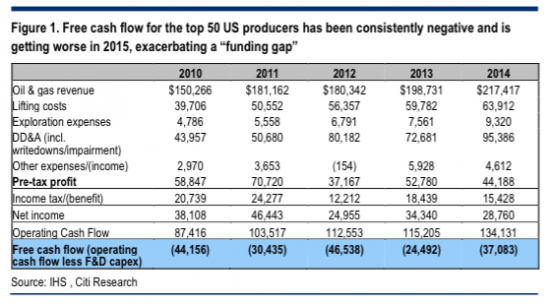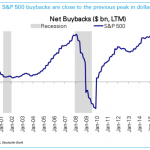“Two things become clear in an analysis of the financial health of US hydrocarbon production: 1) the sector is not at all homogenous, exhibiting a range of financial health; 2) some of the sector indeed looks exposed to distress [and] lifelines for distressed producers could include public equity markets, asset sales, private equity, or consolidation. If all else fails, Chapter 11 may be necessary.” That’s Citi’s assessment of America’s “shale revolution”, which the Saudis have been desperately trying to crush for more than a year now.
As Citi and others have noted – a year or so after we discussed the issue at length – uneconomic producers in the US are almost entirely dependent on capital markets for their continued survival. “The shale sector is now being financially stress-tested, exposing shale’s dirty secret: many shale producers depend on capital market injections to fund ongoing activity because they have thus far greatly outspent cash flow,” Citi wrote in September. Here’s a look at what the bank means:

Of course this all worked out fine in an environment characterized by relatively high crude prices and ultra accommodative monetary policy. The cost of capital was low and yield-starved investors were forgiving, allowing the US oil patch to keeping drilling and pumping long after it should have been bankrupt. Now, the proverbial chickens have come home to roost. In the wake of the Fed hike, HY is rolling over and as UBSnoted over the summer, “the commodity related industries total 22.8% of the overall HY market index on a par-weighted basis; sectors most at-risk for defaults (defined as failure to pay, bankruptcy and distressed restructurings) total 18.2% of the index and include the oil/gas producer (10.6%), metals/mining (4.7%), and oil service/equipment (2.9%) industries.” As Bruce Richards, chief executive officer of Marathon Asset Management told Bloomberg last week, “the price of a barrel of oil could fall below $30 due to a “glut of supply,” and as many as a third of energy companies will default over the next three years.”













Leave A Comment